Search
Total 39 results were found for your query amphibian.
-
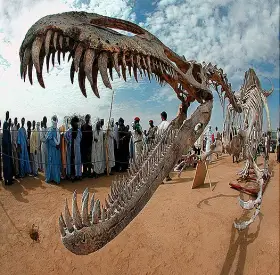 Zoology
ZoologyPALAEONTOLOGICAL EVIDENCES OF ORGANIC EVOLUTION
... parts. Hence fossils are very less in that period. B. Palaeozoic era: In this era, advanced invertebrates and primitive vertebrates (Fishes,Amphibians) arose. C. Mesozoic era: In ...Created on 10 June 2017 -
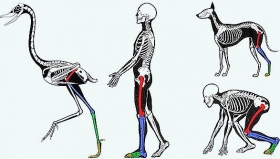 Zoology
ZoologyCOMPARATIVE ANATOMY
Definition of Comparative Anatomy: is a one of the branches of biology studying the similarities and differences of internal organs between different groups of organisms. The following topics are ...Created on 08 June 2017 -
 Zoology
ZoologyVERTEBRATES
... IN SHARKS CLASPERS IN SHARKS INTERNAL EAR OF SHARK (OR) MEMBRANOUS LABRYTH AMPULIAE OF LORENZINI IN FISHES AMPHIBIANS AN INTRODUCTION TO AMPHIBIANS GENERAL CHARACTERS OF AMPHIBIA ...Created on 07 June 2017 -
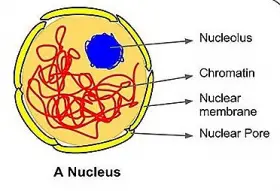 Cell Biology
Cell BiologySTRUCTURE AND FUNCTION OF CELL NUCLEUS
... Ex. Amphibian oocyte. The size of the nucleolus is depended upon the activity of the cell. They may be smaller or big. The nucleous shows two parts, a) Amorphous part, b) Filamentous part. ...Created on 07 June 2017 -
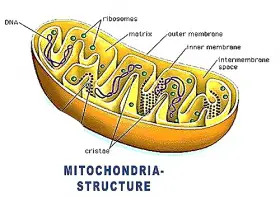 Cell Biology
Cell BiologySTRUCTURE AND FUNCTION OF MITOCHONDRIA
... The width is .5 to .7 microns (Oocyte of amphibian show 20 to 40 microns length mitochondria.) Shape: They are filamentous or they may show rod, spherical, or thread like structures. Number: ...Created on 06 June 2017 -
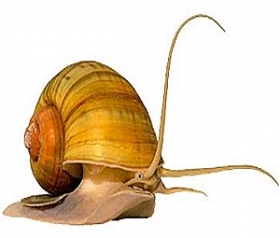 Zoology
ZoologySENSE ORGANS IN PILA (SNAIL)
Pila is an amphibian. It shows many sense organs. They are ospharadium, eyes, statocyst and tentacles 1. Ospharadium Near the left pseudepipodium attached to the pulmonary sac a leaf like ospharadium ...Created on 04 June 2017 -
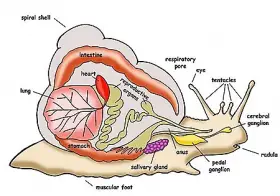 Zoology
ZoologyRESPIRATORY SYSTEM OF PILA (SNAIL)
Pila is a amphibian. When it is in water, it will perform branchial respiration with the help of gill. When it is on land it will perform pulmonary respiration with the help of pulmonary chamber. Branchial ...Created on 04 June 2017 -
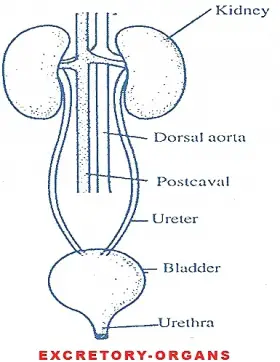 Zoology
ZoologyEXCRETORY SYSTEM OF RABBIT
EXCRETION - BASICS The amino acids which are transported to different tissues along with other food stuffs are involved in synthesis of essential proteins and some others for producing energy. ...Created on 24 May 2017 -
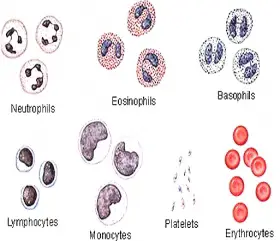 Hemotology
HemotologyCOMPOSITION OF BLOOD AND ITS FUNCTIONS
The blood is red in color and circulates in the body like a river. The blood consists of a homogenous fluid called plasma constituting 55% and the remaining 45% by three types of blood corpuscles. ...Created on 23 May 2017 -
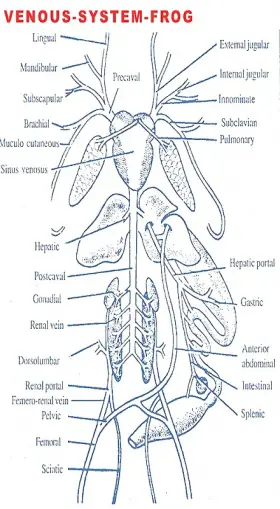 Zoology
ZoologyCOMPARATIVE ANATOMY: VENOUS SYSTEM OF FROG (AMPHIBIAN) AND RABBIT (MAMMAL)
VENOUS SYSTEM OF FROG (AMPHIBIAN) AND RABBIT (MAMMAL) - SIMILARITIES AND DIFFERENCES Rabbit - Venous system Frog - Venous system 1. Coronary veins collecting the blood from the wall of ...Created on 23 May 2017 -
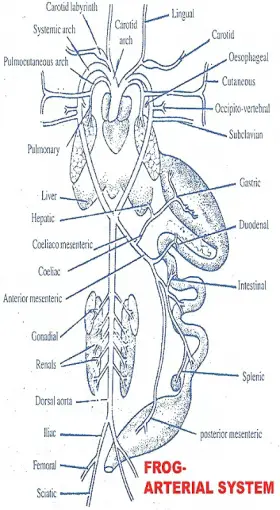 Zoology
ZoologyCOMPARATIVE ANATOMY: ARTERIAL SYSTEM OF RABBIT AND FROG
SIMILARITIES AND DIFFERENCES OF ARTERIAL SYSTEM OF MAMMAL (RABBIT) AND AMPHIBIAN (FROG) Rabbit - Arterial System Frog - Arterial System 1. The blood to different parts of ...Created on 22 May 2017 -
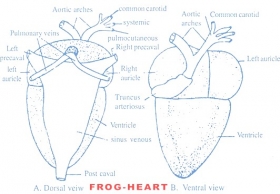 Zoology
ZoologyCOMPARATIVE ANATOMY: HEART OF RABBIT AND FROG
SIMILARITIES AND DIFFERENCES BETWEEN RABBIT HEART (MAMMAL) FROG HEART (AMPHIBIAN) Rabbit Frog 1. The heart of rabbit is four chambered with two auricles and two ...Created on 21 May 2017 -
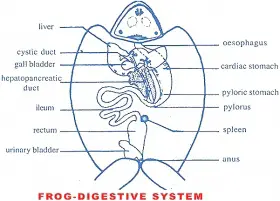 Zoology
ZoologyCOMPARATIVE ANATOMY: RABBIT AND FROG DIGESTIVE SYSTEMS
SIMILARITIES AND DIFFERENCES IN DIGESTIVE SYSTEM OF MAMMAL (RABBIT) AND AMPHIBIAN (FROG) Table 325.1: Similarities and differences between the digestive system of the mammal and amphibian Rabbit ...Created on 20 May 2017 -
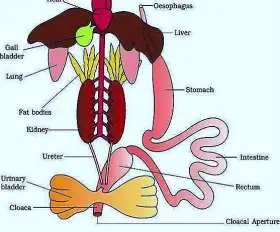 Zoology
ZoologyCOMPARATIVE ANATOMY: FROG DIGESTIVE SYSTEM AND SHARK DIGESTIVE SYSTEM
Comparison Of Digestive System Of Shark Fish (Scoliodon) With Digestive System Of Frog (Rana - Amphibian) Scoliodon is an aquatic cartilage fish, Rana is an amphibian. Scoliodon is a carnivorous ...Created on 18 May 2017 -
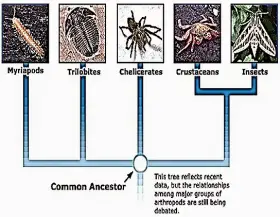 Zoology
ZoologyPHYLUM ARTHROPODA: CHARACTERISTICS AND CLASSIFICATION
... are temporary ectoparasites of fresh water and marine fishes and some amphibians. Ex: Argulus (carp lice). Sub-Class 7: Cirripedia (Barnacles): These are marine, sessile, parasitic or fixed to rocks, ...Created on 14 May 2017 -
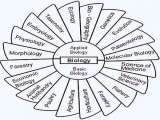 Zoology
ZoologyBRANCHES OF BIOLOGY
... of characters from parents to offspring. Ichthyology — Study of fishes or study of fishes and amphibians. Internal Morphology — It deals with the internal structure of plant parts and also called anatomy. ...Created on 20 April 2017 -
 Microbiology
MicrobiologyPlatelets Count
... are found only in mammals, whereas in other animals (e.g. birds, amphibians) thrombocytes circulate as intact mononuclear cells. There are two methods for estimation of erythrocyte count: • Manual or ...Created on 28 April 2016 -
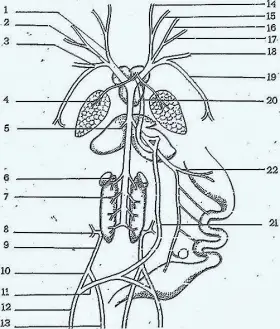 Zoology
ZoologyCOMPARATIVE ANATOMY: VENOUS SYSTEM OF FROG AND FISH
Scoliodon commonly called as shark fish is a poikilothermic (cold blooded) animal. It is cartilaginous fish. Rana (frog) is also poikilothermic and amphibious animal. The circulation of blood in vertebrates ...Created on 14 July 2009 -
 Zoology
Zoology15 Main Theories of Biological Evolution of Man (with Statistics)
... in water. The second incarnation according to Das was a turtle (Kurma avatar), an amphibian. The next incarnation was a wild pig (Baraha avatar) which represents land-living animals. The fourth incarnation ...Created on 28 April 2009